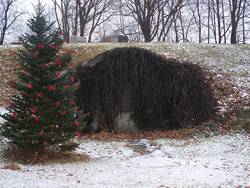 In the year 1847, the small village of Wooster Ohio was experiencing its usual white and wintry weather as the month of December slowly plodded its way out. Scarcely 40 years old, this village named for General David Wooster was but a shadow of the 25,000-strong city that it is today.
In the year 1847, the small village of Wooster Ohio was experiencing its usual white and wintry weather as the month of December slowly plodded its way out. Scarcely 40 years old, this village named for General David Wooster was but a shadow of the 25,000-strong city that it is today.
During those quiet days, a young 19-year-old German immigrant closed his tailoring business and made his way home through the tiny streets of this little village. The Christmas Holiday was on its way, and this young man was troubled. He had been in Wooster for some time and found himself longing for the warm familiarity of his childhood home. It is difficult to say what was on his mind as he lay down to rest that night, or how many days he had pondered a growing idea.
Finally a day dawned, and this young man took action.
His name was August Imgard, and he had decided that he would bring an old Bavarian tradition back into his little home in America. It is said that he crossed Little Apple Creek and made his way to a Blue Spruce tree that grew in the woods just outside the village. He cut it down and dragged it back to his home (much to the curiosity of his neighbors – this tradition had only just appeared in Ohio 11 years prior in Cincinnati) where he and his wife Jeanette set it up inside. He then walked his way to the local smith where he had a tin star made to adorn the top of that tree. He decorated the branches with paper ornaments as visions from his childhood raced through his head.
 Young August then made his way to the tiny kitchen and began to boil a pot of sugar – it was an old German recipe for candy sticks. When the candy had reached the perfect consistency, he removed it from the heat and began to let the sweet syrup cool and harden. At the perfect time he took small amounts of the sticky concoction and rolled it out. These white sticks of candy were then lovingly bent at their tops so that they would hang festively on August’s Christmas Tree. He called them “sugar crooks”.
Young August then made his way to the tiny kitchen and began to boil a pot of sugar – it was an old German recipe for candy sticks. When the candy had reached the perfect consistency, he removed it from the heat and began to let the sweet syrup cool and harden. At the perfect time he took small amounts of the sticky concoction and rolled it out. These white sticks of candy were then lovingly bent at their tops so that they would hang festively on August’s Christmas Tree. He called them “sugar crooks”.
So did the familiar candy cane become a part of the Christmas Tree tradition in America! It would take a few decades for the familiar red stripe to be applied to the sweet treat, but the practice of hanging these candies on the evergreen branches began to spread like wildfire and thus became a permanent fixture in American culture. And to this very day each Christmas a tree is lit up at the tomb of August Imgard (seen above), who went to his rest in 1904 in Wooster.
To see candy canes being made by hand with the now familiar red stripe, watch the video below by McCord’s Candies.

